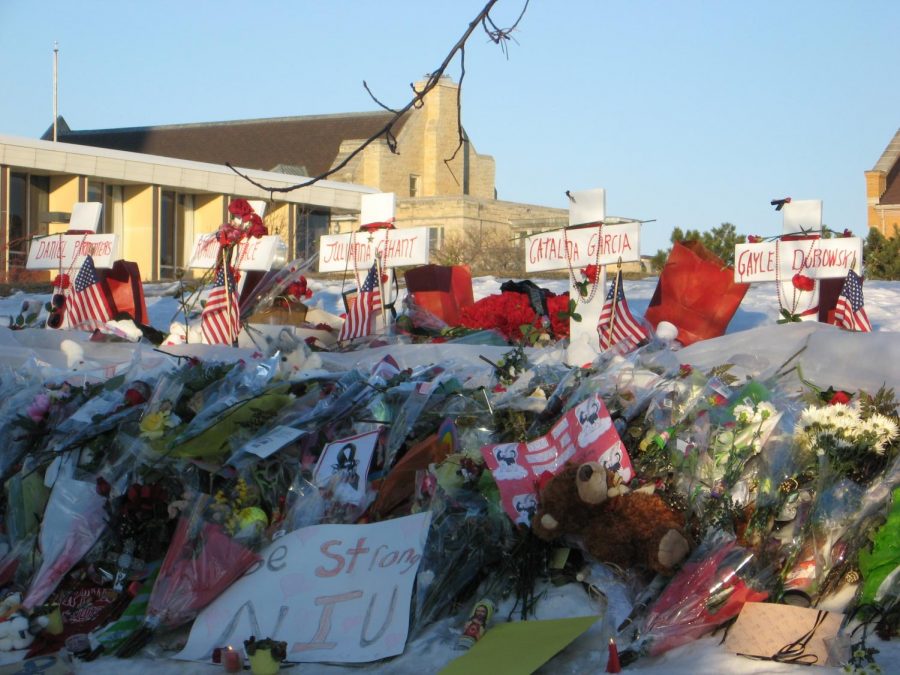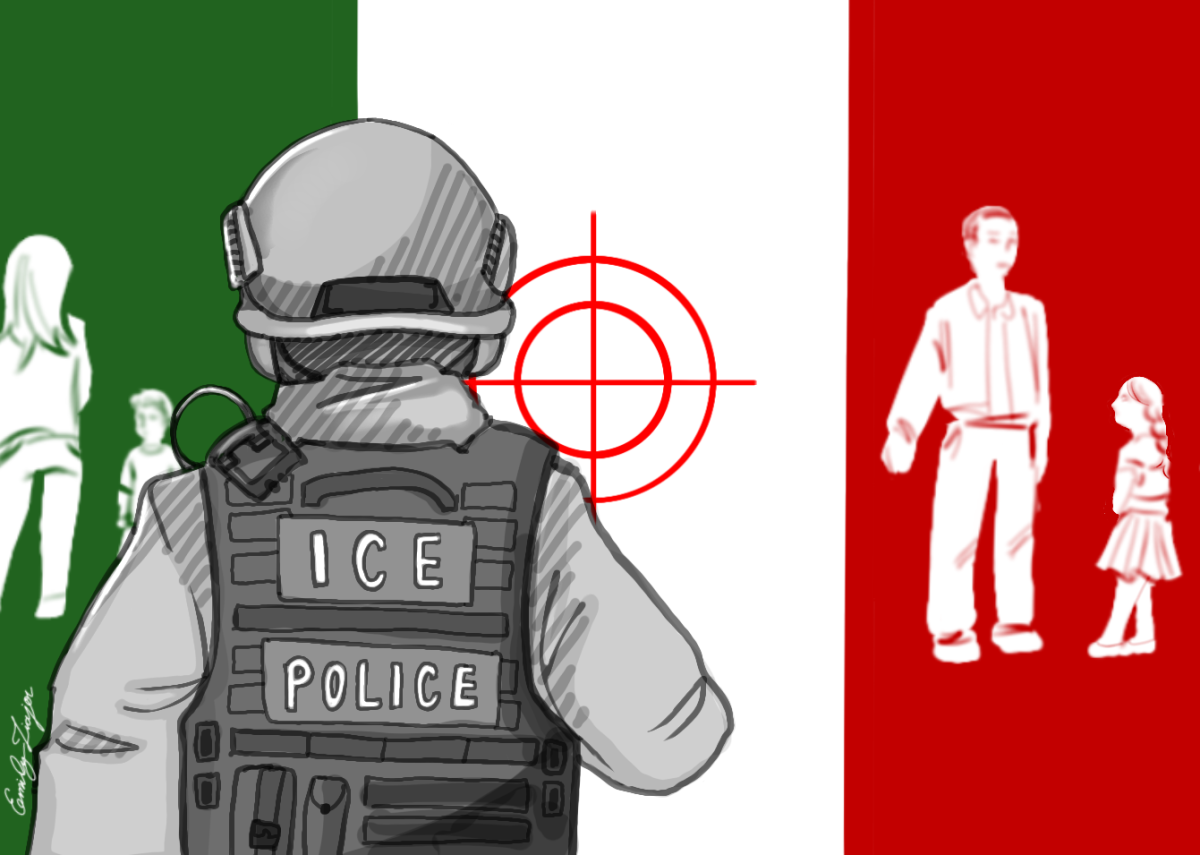The Trauma that Persists: How counseling helps survivors after school shootings
After Northern Illinois’ 2008 shooting, killing six and injuring 21 people, the school solicited help from licensed counselors to help students cope with symptoms resulting from the senseless trauma. What services should be available to students, friends and family after such tragedies? And in the long-run, what required attention is still needed to make sure the tragedy doesn’t claim any more lives?
May 17, 2019
Sacrificing their lives to save others, two students caught in the most recent school shootings are being hailed as “heroes” for embodying the courage they never should have had to show.
Kendrick Castillo, 18, died while blocking the gunman with three other students during the shooting at STEM School Highlands Ranch in Colorado, resulting in eight other students wounded. Castillo loved engineering and was soon to graduate high school.
Riley Howell, 21, an R.O.T.C. cadet, died tackling the gunmen during the shooting at the University of North Carolina at Charlotte, resulting in one other student killed and four more wounded. Howell was a soccer goalie when in high school.
As College of DuPage mental health counselor Dennis Emano knows, unless properly treated, the trauma experienced by students, friends and family can have lingering and debilitating psychological effects. Emano, also a licensed psychologist, stressed, students who are experiencing symptoms of anxiety and depression must find the courage to seek help.
“We are professionals and know how to cope with problems arising from experiencing a traumatic event,” said Emano. “It is wonderful, and often crucial to have a social support system of family or friends, but they are not trained in directly helping people effectively cope.”
Since the 1999 Columbine High School shooting (killing 15 people), CBS News has reported an estimated 228,000 American students have experienced gun-related violence at their school. CNN has documented 35 school shootings in this school year alone.
The National Center for PTSD estimates one-third of people who experience a traumatic event will develop acute stress disorder, with symptoms lasting about a month after the trauma. Twenty-eight percent of people will develop the more long-term post-traumatic stress disorder.
Symptoms beleaguering the person include excessive and often debilitating anxiety, disturbed sleep patterns, vivid flashbacks and a disassociation from the emotional and physical realities of everyday life.
The Giffords Law Center to Prevent Gun Violence reports 40 percent of children who experience gun violence show symptoms of PTSD. The nonprofit encourages lawmakers to ensure minors are denied access to firearms, especially minors who pose a threat to themselves or others.
Emano believes if these symptoms linger, the person must be willing to openly address and combat the problems they are dealing with. Nobody should feel guilty or weaker than others for having to seek help. Everyone copes and heals from trauma and tragedy differently.
“The biggest psychological problem people face after traumatic events is anxiety,” said Emano. “This includes avoidance of situations and social settings. Many things in the environment can trigger intense flashbacks of the trauma, leading to a sudden panic attack. Due to the fear of incessant panic attacks, they learn to avoid certain situations to protect themselves. However, avoiding social situations is not a healthy solution for the anxieties in anyone’s life. As counselors, we encourage the person to incrementally expose themselves to the situation that may cause stress. Slowly, this will help diminish the anxiety effectively.”
The statistics behind those who suffer from lingering symptoms have been made all the more real by the recent suicides of two survivors of the Parkland shooting and a father whose daughter was killed in Sandy Hook.
Sydney Aiello, 19, a student at Florida Atlantic University, ended her life after a struggle with what her mother called survivor’s guilt, resulting from the shooting at Majory Stoneman Douglas High School (killing 17 people). Aiello’s close friend, Meadow Pollack, was among those who perished in the carnage.
Another survivor of the attack, Calvin Desir, 16, killed himself within days of Aiello.
As NBC News detailed following Aiello’s suicide, when an individual struggles to accept that control over external events is out of their hands, they manifest a false sense of control by blaming themselves. The person constantly asks, ‘What could I have done to change the circumstances?’ ‘What did I fail to do when the situation arrived?’
In comparing themselves to the victims, people can internalize the frustrations into self-depreciating thoughts and anger against their self. They often ask, ‘Did I really deserve to live, while better people than me died?’
Emano said people fear if they lack control, there’s nothing preventing the trauma from reoccurring. He said the most popular evidence-based counseling technique to address this problem is cognitive behavioral therapy. The therapy includes changing the way you think about things to alter the way you feel and respond to certain situations.
“People experience grief in many different ways, often through guilt or anger” said Emano. “We help progress through stages of grief and work towards acceptance that the event happened, and you can’t do anything to change that. Using this approach, we look realistically at what your actions were during the event. We look at the limitations you were under during the event. By challenging these false assumptions, we can change the thinking around the event and hopefully reduce the patient’s anxiety.”
The American Psychological Association says the majority of people who experience a traumatic event do not develop long-term persistent symptoms and are able to address the anxiety with resiliency.
However, for those closer to the trauma, those with emotional connections, those with poor mental health histories, or those who lack proper social support, grief and anxiety can wax and wane with varying intensity.
Anniversaries, and even innocuous popping sounds, the sight of blood, or a bad dream, can cause flashbacks and a relapse into depression, terror and anxiety.
Symptoms can become especially dangerous when the original outpouring of social sympathy and counseling dissipates into isolation. As the social support network decreases, the individual is left with symptoms that may be getting stronger instead of lessening.
Jeremy Richman, took his life more than six years after the death of his daughter, Avielle, in the 2012 Sandy Hook Elementary School Shooting (killing 28 people). Richman, a neuropharmacologist, committed suicide in the building housing the Avielle Foundation, the violence-prevention nonprofit he created in his daughter’s memory.
The American Psychological Association identifies three phases of healing: the acute, intermediate, and long-term phase. The acute phase, immediately following the trauma, is often characterized by denial, shock and disbelief. The intermediate phase, lasting several days to weeks after the trauma, often includes fear, anger, anxiety, difficulty paying attention, depression and disturbed sleeping habits.
While most people find resiliency and abatement from the symptoms by then, those who enter the long-term phase, suffer from debilitating anxiety, flashbacks, and are susceptible to self-medicating to escape their anxiety and depression.
Emano said, by using cognitive behavioral therapy, counselors and therapists can help strengthen the patient’s responses to both external and internal challenges and help build greater resiliency.
“By helping to influence the patient’s thoughts and behaviors, we hope to reduce the anxiety so patients no longer have to avoid certain stressful situations,” said Emano. “We explore the patient’s assumptions, interpretations and beliefs about returning to places where the trauma occurred. We discuss and challenge the notion that another shooting is likely to occur and they have no power to alter their future. We help them recognize the distortions in their cognition. By restructuring these thoughts away from false assumptions, we can focus on healthier thoughts premised on facts and reality.”
Emano said when the 2008 Northern Illinois University shooting occurred, killing six and injuring 21 people, the school solicited outside licensed counseling volunteers to help their students. They outreached to the community because the demand for support overwhelmed the school. In a similar situation, College of DuPage would likely seek outside help.
The college employs two mental health counselors, and based on demand, limits the amount of personal sessions to six meetings with each student. If a breakthrough cannot be made in six sessions, or the student’s symptoms are too severe, the student is referred for outside help.
“We want to know what you are experiencing and assess what troubles you are dealing with,” said Emano. “We then explore their social history. Is there any history of psychological treatment; have they been on medication in the past? Family history can also contribute. We try to develop a full picture of the person’s history to understand what they are currently dealing with. We then ask them what they are looking for. Some students only come here because they were told by a teacher or a parent to come. It’s hard to breakthrough with the student unless the student has a motivation for counseling and improving.”
Emano said the college’s counseling services tries to reach out to students through forums and mass emails. Faculty often tells students counseling is available if needed. He stressed, people need to make the choice to come in, and they will always be here to help.
For students looking to make a career out of helping others through psychology or counseling, Emano said empathy is the most important quality to possess.
“It can be difficult trying to breakthrough with a patient,” said Emano. “If you can be empathetic, you can help create safe-space for the student to disclose their personal feelings. You have to put yourself in the other person’s shoes and understand what they are experiencing and feeling. If you can make the patient feel they are being heard and cared about, your understanding and compassion will help alleviate their suffering.”




















